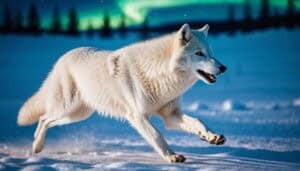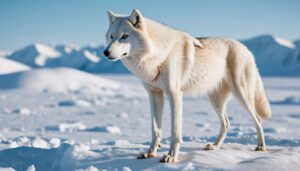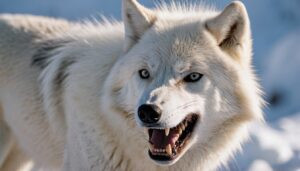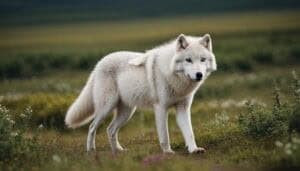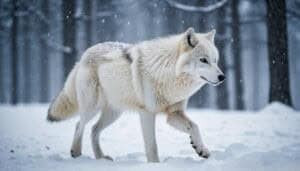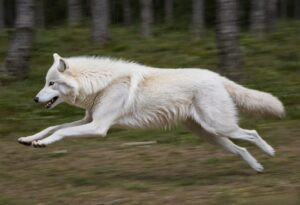Introduction
The Arctic wolf, a subspecies of the gray wolf, has adapted to survive in one of the harshest environments on Earth. Among its many adaptations, the tail plays a crucial role in maintaining balance
This article explores how the Arctic wolf’s tail helps it navigate uneven and snowy terrain, supports specific behaviors, and contributes to its overall structural and adaptive advantages
How the Arctic Wolf’s Tail Contributes to Balance
The Arctic wolf’s tail is a multifaceted tool essential for maintaining balance in its icy and uneven habitat. This section delves into the various roles the tail plays in ensuring the wolf can move efficiently and safely across its environment
Role in Movement on Uneven Terrain
The Arctic wolf often traverses rocky, snow-covered landscapes where footing can be treacherous. The tail acts as a counterbalance, helping the wolf maintain stability. When the wolf navigates slopes or uneven ground, it shifts its tail position to counterbalance its body weight, preventing slips and falls. This tail adjustment is instinctive and precise, allowing the wolf to move swiftly and confidently despite the challenging terrain
Additionally, the tail provides a balancing effect during quick movements or sudden changes in direction. When chasing prey or evading threats, the Arctic wolf relies on its tail to help stabilize sharp turns and maintain momentum. This agility is crucial for survival in the wild, where speed and balance can make the difference between catching a meal and going hungry
Navigation in Snowy Environments
Snowy conditions present another set of challenges for the Arctic wolf. Deep snow can make movement laborious and energy-consuming. The tail aids in balance by acting as a rudder, helping the wolf maintain a straight path and avoid stumbling in deep snow. As the wolf moves, its tail adjusts to slight changes in the snow’s consistency and depth, providing real-time balance corrections
In addition to aiding in movement, the tail helps the Arctic wolf gauge its environment. By sensing changes in the snow’s texture and stability through its tail, the wolf can better predict and respond to potential hazards, such as hidden ice patches or unstable snowbanks. This sensory feedback is vital for the wolf’s ability to move efficiently and safely across its snowy domain
Specific Behaviors and Tail Function
Beyond general movement, the Arctic wolf’s tail is integral to several specific behaviors that require precise balance. During hunting, for example, the wolf’s tail plays a critical role in stalking prey. As the wolf moves stealthily, its tail helps maintain a low center of gravity, allowing for quieter and more controlled movements. This stealth is essential for successful hunts, as prey in the Arctic can be scarce and challenging to catch
Similarly, the tail is used for communication during pack interactions. Wolves use their tails to signal various emotions and intentions, from dominance displays to submission. In these interactions, balance is crucial to maintaining the correct body posture. The tail helps the wolf hold these postures more effectively, ensuring that its messages are clearly communicated to other pack members
Overall, the Arctic wolf’s tail is a vital tool for maintaining balance in its harsh environment. Whether navigating uneven terrain, moving through snow, or engaging in specific behaviors, the tail’s ability to provide stability and feedback is essential for the wolf’s survival and success in the Arctic wilderness
Structural and Adaptive Advantages of the Arctic Wolf’s Tail
The Arctic wolf’s tail is not only a tool for balance but also a marvel of evolutionary adaptation. Its structure and various functions highlight how it has evolved to suit the wolf’s needs in its icy habitat. This section examines the anatomical features of the tail and its coordination with other body parts, compares it with other wolves, and explores its environmental adaptations, role in hunting, and function during resting periods
Tail Anatomy and Balance
The Arctic wolf’s tail is thick, bushy, and well-insulated with fur. This dense fur not only protects the tail from the cold but also adds to its mass, making it a more effective counterbalance. Inside, the tail comprises a series of vertebrae that give it flexibility and strength. These vertebrae are connected by muscles and tendons that allow for precise movements and adjustments, essential for maintaining balance
The tail’s length and flexibility are particularly advantageous. A longer tail can provide a greater counterbalance effect, while its flexibility allows the wolf to make subtle adjustments. Whether the wolf is standing still on an uneven surface or sprinting after prey, its tail can move to stabilize its body, ensuring that it remains upright and agile
Coordination with Other Body Parts
The Arctic wolf’s tail works in concert with other parts of its body to maintain balance. The wolf’s ears, eyes, and limbs all play roles in its overall equilibrium. For instance, as the wolf moves, its ears help it detect changes in its surroundings, and its eyes provide visual feedback on the terrain. The tail then acts on this information, adjusting its position to maintain stability
The coordination between the tail and the limbs is particularly critical. As the wolf walks, runs, or jumps, its legs provide the primary support and propulsion. The tail complements these movements by adjusting to shifts in the wolf’s center of gravity. This dynamic interplay between the tail and the limbs ensures that the wolf can move efficiently and maintain balance in various situations
Comparison with Other Wolves
While all wolves use their tails for balance, the Arctic wolf’s tail has unique adaptations that set it apart. Compared to wolves in more temperate climates, the Arctic wolf’s tail is thicker and more heavily furred, providing better insulation against the cold. This additional fur also enhances its counterbalance function, making it particularly suited to the Arctic environment
Moreover, the Arctic wolf’s tail is slightly longer in proportion to its body than that of other wolves. This length gives it a greater range of motion and flexibility, essential for navigating the challenging terrain of the Arctic. These adaptations highlight how the Arctic wolf has evolved to use its tail more effectively in maintaining balance compared to its relatives
Environmental Adaptations
The Arctic environment poses unique challenges, and the wolf’s tail has evolved to address these. The thick fur not only insulates against the cold but also helps the wolf maintain balance on slippery or unstable surfaces. In the deep snow, the tail acts like a rudder, helping the wolf navigate and maintain a straight path. This is particularly important when the wolf is traveling long distances in search of food or shelter
Role in Hunting
During hunts, the Arctic wolf’s tail is an essential tool for balance and agility. As the wolf stalks its prey, the tail helps it move stealthily and maintain a low profile. When the chase begins, the tail aids in making sharp turns and sudden bursts of speed, ensuring that the wolf can keep up with its quarry. This balance and agility are crucial for successful hunts, as the prey in the Arctic is often fast and elusive
Function During Resting Periods
Even during rest, the tail plays a role. When the Arctic wolf lies down, it often curls its tail around its body. This not only helps retain heat but also provides additional stability, especially when resting on uneven surfaces. The tail acts as a support, helping the wolf maintain a comfortable and balanced resting position
Conclusion
The Arctic wolf’s tail is a crucial adaptation that plays multiple roles in maintaining balance and aiding survival in its harsh, icy environment. Its thick, bushy structure provides insulation and acts as a counterbalance during movement on uneven terrain, enabling the wolf to navigate rocky and snowy landscapes with agility and precision
The tail’s flexibility and length allow for subtle adjustments that stabilize the wolf during sudden movements and direction changes, essential for hunting and evading threats
Coordinating with other body parts, the tail helps the wolf maintain equilibrium by working in tandem with its eyes, ears, and limbs. This coordination ensures efficient and balanced movement, even in the most challenging conditions. Compared to other wolves, the Arctic wolf’s tail is uniquely adapted to its environment, with thicker fur and a longer, more flexible structure that enhances its balancing function
The tail’s role extends beyond movement, aiding in specific behaviors such as stalking prey and communicating within the pack. It also provides stability and warmth during resting periods, highlighting its multifunctional importance. Overall, the Arctic wolf’s tail is a vital tool that exemplifies the remarkable adaptations of this species to its extreme habitat


